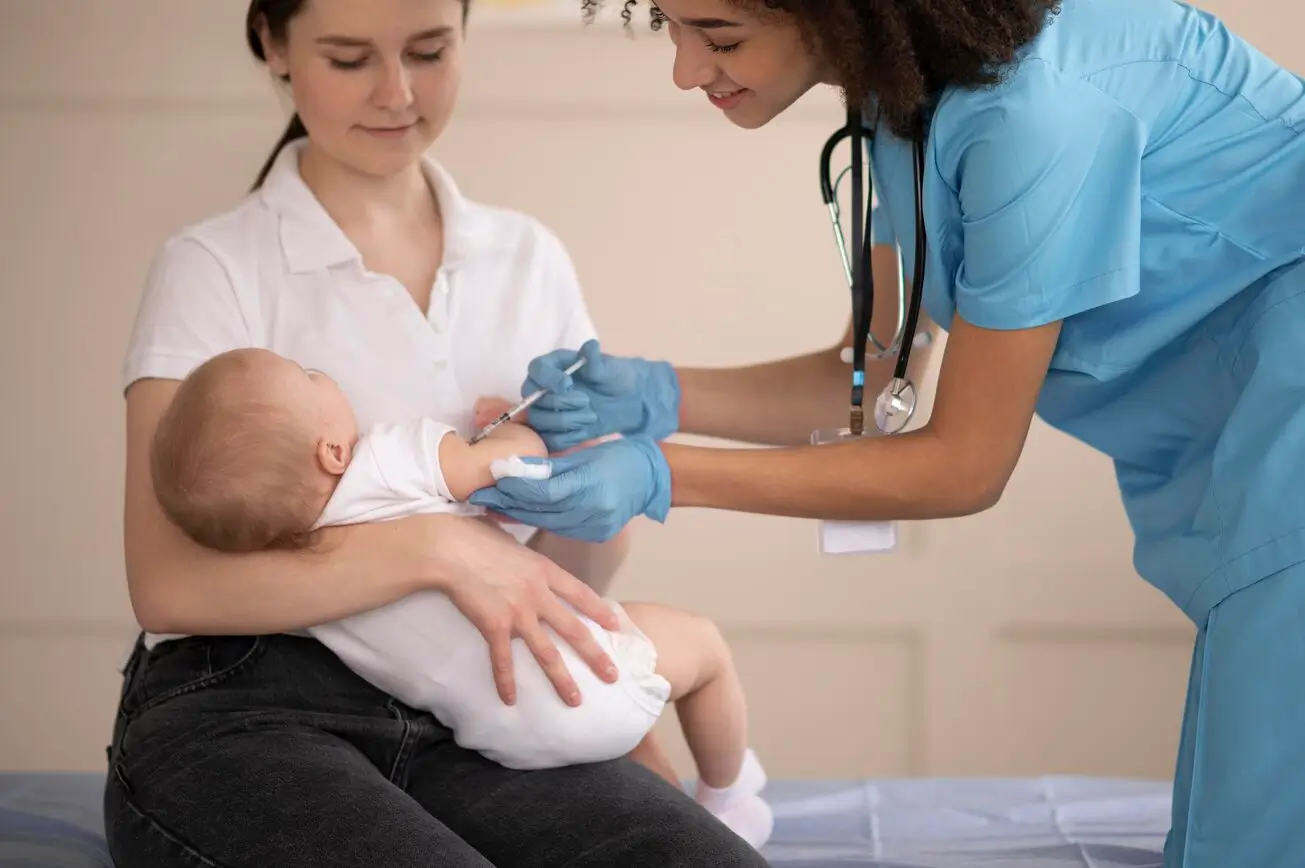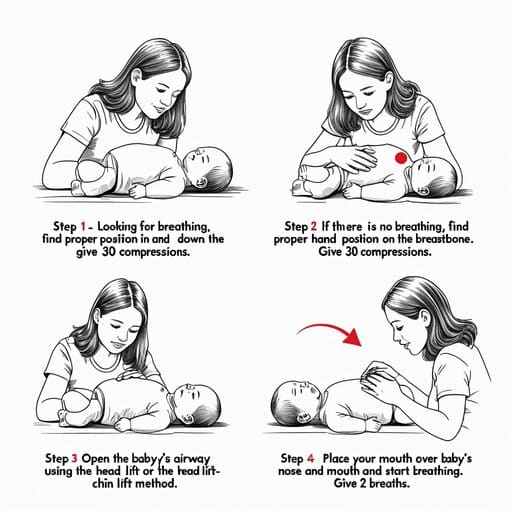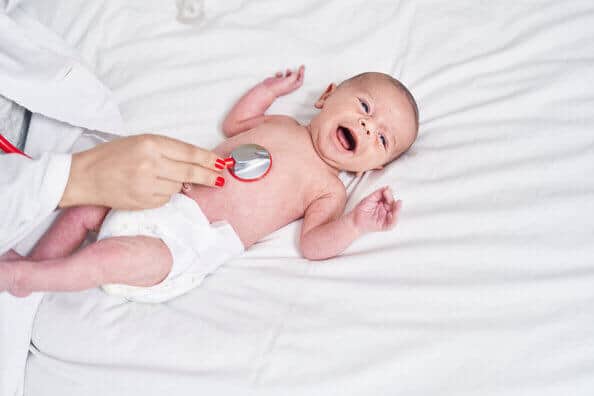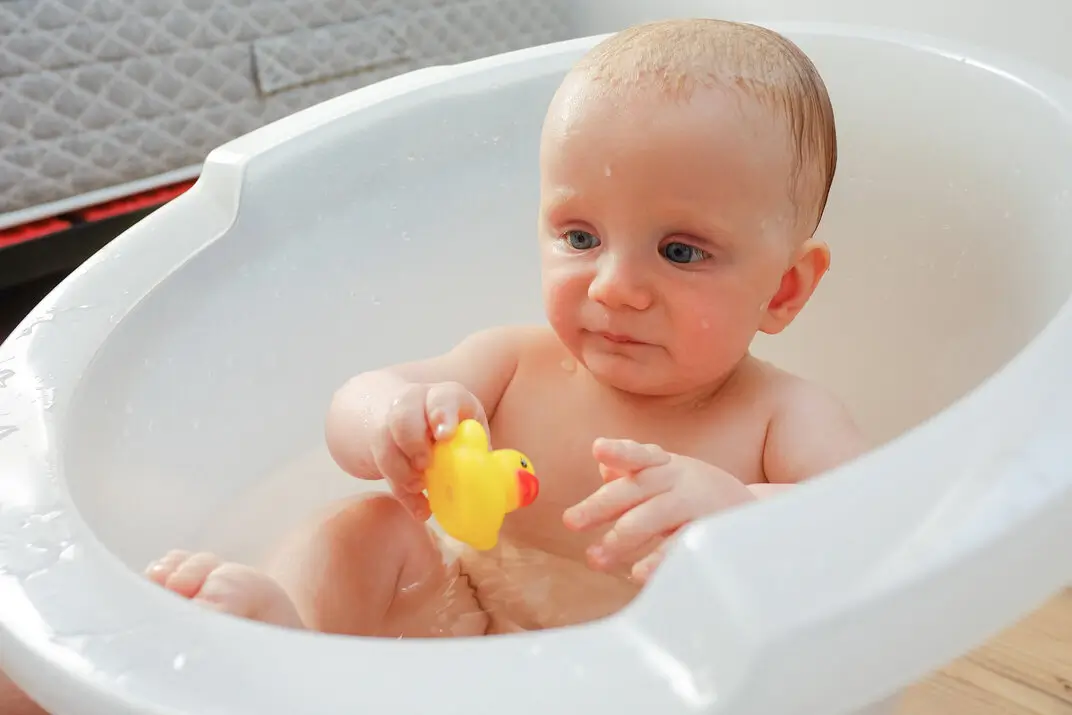Newborn First Aid starts with quick action in critical moments: for an unresponsive, non-breathing baby, perform CPR with 30 chest compressions using two fingers followed by two rescue breaths; if unresponsive but breathing, use the recovery position; for choking, alternate five back blows and five chest thrusts.
As parents in the USA, facing a newborn emergency can feel overwhelming, but knowing Newborn First Aid basics can make all the difference. Every year, over 20,000 infants die in the United States from preventable causes, including sudden unexpected deaths and accidents like choking. These numbers from the CDC highlight why Newborn First Aid knowledge is essential for babies’ parents.
This guide draws from the latest 2025 American Heart Association guidelines and real-world experiences to equip you with practical steps for handling unresponsive or choking situations in newborn babies from birth to 28 days old. Unlike basic lists online, we’ll blend official protocols with tips on preparation, emotional support, and prevention, all tailored for everyday parents. Whether you’re stocking a first aid kit for babies or practicing drills at home, this article from LoveBabyGo, your trusted baby brand, aims to build your confidence in Newborn First Aid.
Key Takeaways
Master Newborn First Aid techniques like CPR and choking relief to respond effectively in emergencies.
Prepare a comprehensive first aid kit for baby, including essentials like a nasal aspirator and thermometer, to handle common issues.
Recognize early signs of distress in newborns, such as blue skin or limpness, to act before situations worsen.
Always call 911 immediately in the USA for any unresponsive baby, even if breathing.
Practice Newborn First Aid regularly through courses or home drills to stay sharp and reduce panic.

Newborn First Aid: Getting Ready with Baby’s First Aid Kit
Newborns have unique bodies that make them more prone to emergencies, and understanding this is key to effective care. Their airways are tiny and easily blocked, their lungs are underdeveloped, and their immune systems are just starting out, which means even minor issues can escalate fast. For instance, a simple feeding mishap can lead to choking because their swallow reflex isn’t fully mature yet.
Spotting trouble early is crucial in Newborn First Aid. Look for signs like no response to touch or sound, which signal unresponsiveness. If the skin turns blue around the lips or face, known as cyanosis, or if there’s unusual grunting, these could indicate breathing problems. Normal newborns breathe 40 to 60 times per minute, but anything irregular demands immediate Newborn First Aid attention. In the USA, emergency department visits for infants under one are the highest among age groups, with rates around 100 visits per 100 people annually. This statistic underscores how common these scares are.
From a global view, factors like home environments play a role. In urban USA settings, pollution might aggravate respiratory issues, while in rural areas, helps due to distance. Cultural practices, such as swaddling, can aid comfort but risk overheating if done wrong. Always check for sweat or rapid breathing. To make Newborn First Aid more intuitive, use a quick symptoms table:
| Symptom | Normal | Emergency Indicator |
|---|---|---|
| Breathing Rate | 40-60 breaths/min | Under 30 or over 60, irregular |
| Skin Color | Pink, warm | Blue, pale, mottled |
| Responsiveness | Alerts to noise/touch | Limp, no reaction |
This approach helps parents differentiate and apply Newborn First Aid without hesitation.
Essential Preparation for Newborn Emergencies
Getting ready for Newborn First Aid before anything happens sets you up for success. Start by assembling a first aid kit for baby tailored for little ones. Based on expert recommendations, include items like a rectal thermometer for accurate readings, saline drops and a nasal aspirator to clear stuffy noses, and infant acetaminophen for fevers. Always consult with your pediatrician. Add bandages, antibiotic cream, and a medicine dropper. For on-the-go needs, duplicate this first aid kit for babies in your diaper bag.
Training is non-negotiable in Newborn First Aid. Enroll in American Heart Association or Red Cross classes focused on infants. These hands-on sessions teach you to feel the right compression depth. I’ve seen parents transform from nervous to assured after practicing on mannequins. Use apps like those from the AHA for refreshers, and create a family protocol: Assign roles, like one calls 911 while another starts Newborn First Aid.
Mentally, visualize scenarios to stay calm. In the USA, Good Samaritan laws protect you if you act reasonably in Newborn First Aid situations. Tie in safe baby clothes from Lovebabygo breathable fabrics that reduce overheating risks, complementing your first aid kit for baby prep by preventing some emergencies altogether.
Training Focus: Watch CPR Demonstratio.n See proper newborn first aid techniques step-by-step. Our video shows compression depth, choking response, and emergency protocols parents need.
Newborn First Aid: CPR for Babies Who Stop Breathing
When a newborn stops responding and breathing, Newborn First Aid demands swift CPR.
In this illustration, proper finger placement for newborn CPR chest compressions is shown just below the nipple line.
Follow the 2025 AHA guidelines for precision.
Call for Help: Yell for assistance. If alone, do one minute of Newborn First Aid CPR before dialing 911 in the USA. Provide your location clearly.
Check for Breathing: Place the baby on a flat, firm surface. Tilt the head back gently and check for breath sounds or chest movement for 10 seconds max. No signs? Start compressions.
Give 30 Chest Compressions: Use two fingers on the chest center, below the nipples. Push down 1.5 inches, about one-third the chest depth, at 100-120 per minute. This pumps blood in newborns.
Give 2 Rescue Breaths: Seal your mouth over the nose and mouth, giving gentle puffs for one second each. Watch the chest rise; avoid over-blowing to prevent lung damage.
Continue Cycles: Keep the 30:2 ratio until help arrives or the baby revives. If an AED is nearby, use pediatric pads.
Adapt for preemies with lighter pressure. Common mistake: Shallow compressions aim deep but are controlled. This Newborn First Aid sequence has saved countless lives.
Newborn First Aid: Helping Unconscious but Breathing Babies
If the baby doesn’t respond but breathes, focus on airway protection.
Demonstration of the recovery position for a newborn, keeping the head tilted and the airway open.
Position: Roll the baby onto their side, head tilted back and lower than the body. This recovery position drains fluids and keeps the tongue clear.
Call for Help: Contact emergency services right away, noting symptoms and timing for better response.
Monitor: Track breathing count rates and watch for changes. Cover lightly to maintain warmth, as newborns cool quickly during waits.
If breathing falters, switch to full CPR. Partners can help: One monitors, the other gathers info. This method stabilizes until pros arrive.
Newborn First Aid: Saving a Choking Newborn
Choking calls for targeted action to dislodge blockages.

Illustration showing how to perform back blows on a choking newborn, with the head lower than the body.
Back Blows: Hold face-down on your forearm, head low. Give five firm blows between the shoulder blades with your heel.
Chest Thrusts: Turn face-up, head still low. Push five times on the chest center, like CPR, but thrusting inward-upward.
Repeat: Alternate sets until the object clears or the baby cries. Check the mouth only if visible; no blind sweeps.
Unresponsive Baby: If they go limp, start CPR from the earlier section.
Seek Medical Attention: Hospital check post-event for hidden issues like bruising.
Prevent with upright feeding and no small toys. This technique works because gravity aids expulsion.
Newborn First Aid: What to Do After an Emergency
After an emergency, focus on recovery. Watch for breathing return or color improvement as signs of success. Offer skin-to-skin for comfort, aiding bonding post-stress.
Hospital follow-up is vital: Tests might reveal causes like reflux. Ask docs about prevention. For parents, process emotions, join USA support groups, or talk to counselors, as emergency events can linger mentally.
Long-term, adopt safe sleep: Alone on back in crib. Regular check-ups catch issues early, enhancing readiness.
Newborn First Aid: Common Mistakes Parents Make
Myths can hinder emergency response. Myth: Gentle pats clear choking reality: Firm blows are needed. Mistake: Delaying the 911 call.
Best practices: Refresh skills yearly. In high-altitude USA areas, note faster breathing norms. Use tech like baby monitors for early alerts in your first aid kit for babies prep.
Review proper CPR techniques and choking relief methods regularly to avoid common errors.
Baby’s First Aid Kit: Essential Items Every Parent Needs
A well-stocked first aid kit for baby is essential for every parent. Your first aid kit for babies should include a rectal thermometer, saline drops, nasal aspirator, infant acetaminophen, bandages, antibiotic cream, and a medicine dropper. Keep one first aid kit for baby at home and another in your diaper bag. Check your first aid kit for babies every six months to replace expired items.
Dive deeper with AHA’s site for videos or Red Cross apps. Books like “Baby 411” offer insights. Join local USA classes search “infant CPR near me.” Create a practice plan: Weekly reviews build muscle memory.
A well-stocked baby first aid kit, alongside training from the AHA or Red Cross, is vital for every parent’s peace of mind.
For global access, WHO PDFs provide multilingual tips.
Conclusion
Equipping yourself with Newborn First Aid knowledge empowers you to protect your little one. From CPR cycles to choking thrusts, these steps, grounded in 2025 guidelines, can turn panic into action. Remember, preparation with a proper first aid kit for baby and quick response are your best tools to practice today for peace tomorrow.
FAQ
Q: What’s in a first aid kit for babies?
A: Essentials include a thermometer, saline drops, and bandages. Tailor your first aid kit for baby for emergency needs.
Q: How often should I update my first aid kit for baby?
A: Check expiration dates every six months to keep supplies fresh.




